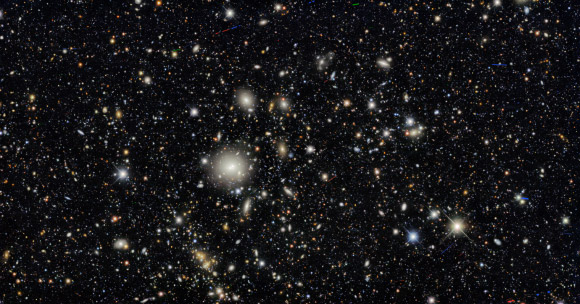Over the course of six years, astronomers with the Dark Energy Survey (DES) surveyed 5,000 square degrees — almost one-eighth of the entire sky — in 758 nights of observation, cataloguing hundreds of millions of objects. Their results, published in 29 new papers, draw on data from the survey’s first three years — 226 million galaxies observed over 345 nights — to create the largest and most precise maps yet of the distribution of galaxies in the Universe at relatively recent epochs.

This deep field image from the Dark Energy Survey is teeming with galaxies; in fact, nearly every single object in this image is a galaxy; some exceptions include a couple of dozen asteroids as well as a few handfuls of foreground stars in our own Milky Way Galaxy. Image credit: Dark Energy Survey / DOE / FNAL / DECam / CTIO / NOIRLab / NSF / AURA / T.A. Rector, University of Alaska Anchorage & NOIRLab / M. Zamani, NOIRLab / D. de Martin, NOIRLab.
DES images the night sky using the 570-megapixel Dark Energy Camera on NSF’s Víctor M. Blanco 4-m Telescope at Cerro Tololo Inter-American Observatory in Chile, a program of NSF’s NOIRLab.
One of the most powerful digital cameras in the world, the Dark Energy Camera was designed specifically for this survey.
“NOIRLab is a proud host for and member of the DES Collaboration,” said Dr. Steve Heathcote, associate director of Cerro Tololo Inter-American Observatory.
“Both during and after the survey, the Dark Energy Camera has been a popular choice for community and Chilean astronomers.”
To test cosmologists’ current model of the Universe, the DES astronomers compared their results with measurements from ESA’s Planck observatory.
Planck used light signals known as the Cosmic Microwave Background to peer back to the early Universe, just 400,000 years after the Big Bang.
The Planck data give a precise view of the Universe 13 billion years ago, and the standard cosmological model predicts how the dark matter should evolve to the present.
If DES’s observations don’t match this prediction, there is possibly an undiscovered aspect to the Universe.
While there have been persistent hints from DES and several previous galaxy surveys that the current Universe is a few percent less clumpy than predicted — an intriguing find worthy of further investigation — the recently released results are consistent with the prediction.
“In the area of constraining what we know about the distribution and structure of matter on large scales as driven by dark matter and dark energy, DES has obtained limits that rival and complement those from the Cosmic Microwave Background,” said Dr. Brian Yanny, an astronomer at DOE’s Fermilab.
“It’s exciting to have precise measurements of what’s out there and a better understanding of how the Universe has changed from its infancy through to today.”
To quantify the distribution of dark matter and the effect of dark energy, the researchers relied mainly on two phenomena.
First, on large scales galaxies are not distributed randomly throughout space but rather form a weblike structure that is due to the gravity of dark matter.
DES measured how this cosmic web has evolved over the history of the Universe. The galaxy clustering that forms the cosmic web in turn revealed regions with a higher density of dark matter.
Second, DES detected the signature of dark matter through weak gravitational lensing.
As light from a distant galaxy travels through space, the gravity of both ordinary and dark matter in the foreground can bend its path, as if through a lens, resulting in a distorted image of the galaxy as seen from Earth.
By studying how the apparent shapes of distant galaxies are aligned with each other and with the positions of nearby galaxies along the line of sight, DES scientists were able to infer the clumpiness of the dark matter in the Universe.
“These analyses are truly state-of-the-art, requiring artificial intelligence and high-performance computing super-charged by the smartest young scientists around,” said Dr. Scott Dodelson, a physicist at Carnegie Mellon University.







